|
|
【中文标题】一百张最有影响力的照片 之二
【原文标题】Most Influential Photos
【登载媒体】时代周刊
【原文作者】Ben Goldberger
【原文链接】http://100photos.time.com/photos/harold-edgerton-milk-drop
消失的道路
爱德华•S•柯蒂斯
1904年
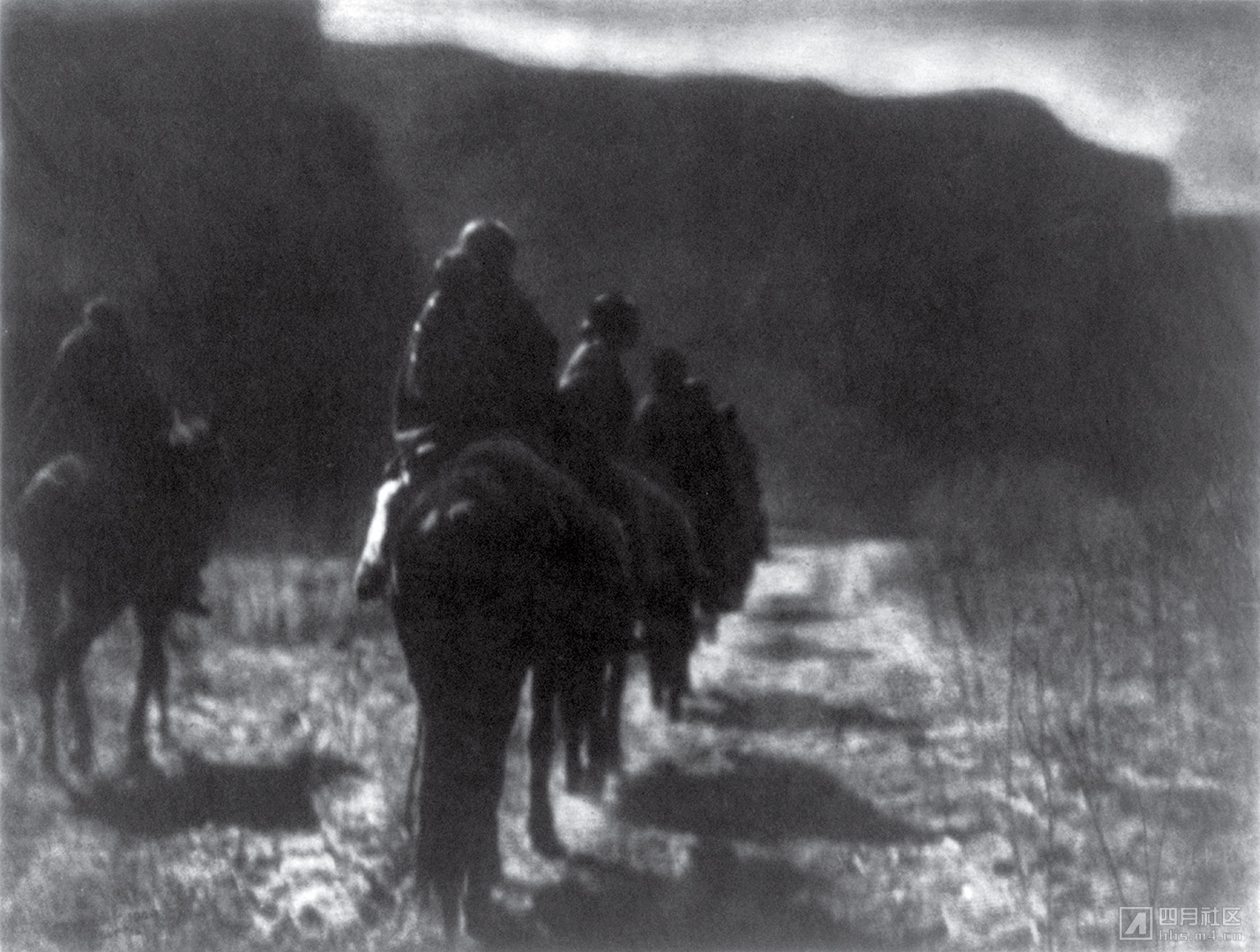
美洲原住民在美国激进的西部扩张中付出了惨重的代价。在殖民者占领了这个年轻国度看似广袤无垠的土地时,他们强迫印第安人离开世代居住的领地,把他们赶到贫穷的保留地,迫使他们与殖民者同化。爱德华•S•柯蒂斯担心美国原住民因此而消失,他决定记录下印第安人的各个部落,把他们描述为高贵的种族——“古代的印第安人,他的服装、他的仪式、他的生活和举止”。柯蒂斯用了二十多年时间把他的照片和观察汇编成《北美印第安人》,一个包括80个部落的20卷编年史。其中最著名的照片是“消失的道路”,纳瓦霍人骑马走向尘土飞扬的远方。在柯蒂斯看来,这张照片浓缩了印第安人的窘境,他们“走向黑暗、未知的未来”。可惜的是,柯蒂斯渊博的作品并没有成功传达出他的本意,而是塑造了一种模式化的观点。铁路公司很快开始把游客送到西部,让他们看一看这些即将消失的种族。印第安人逐渐被视为脱离时代的遗产,而不是现代美国社会不可分割的一部分。这种观点一直持续到今天。
统舱
阿尔弗雷德•斯蒂格里茨
1907年
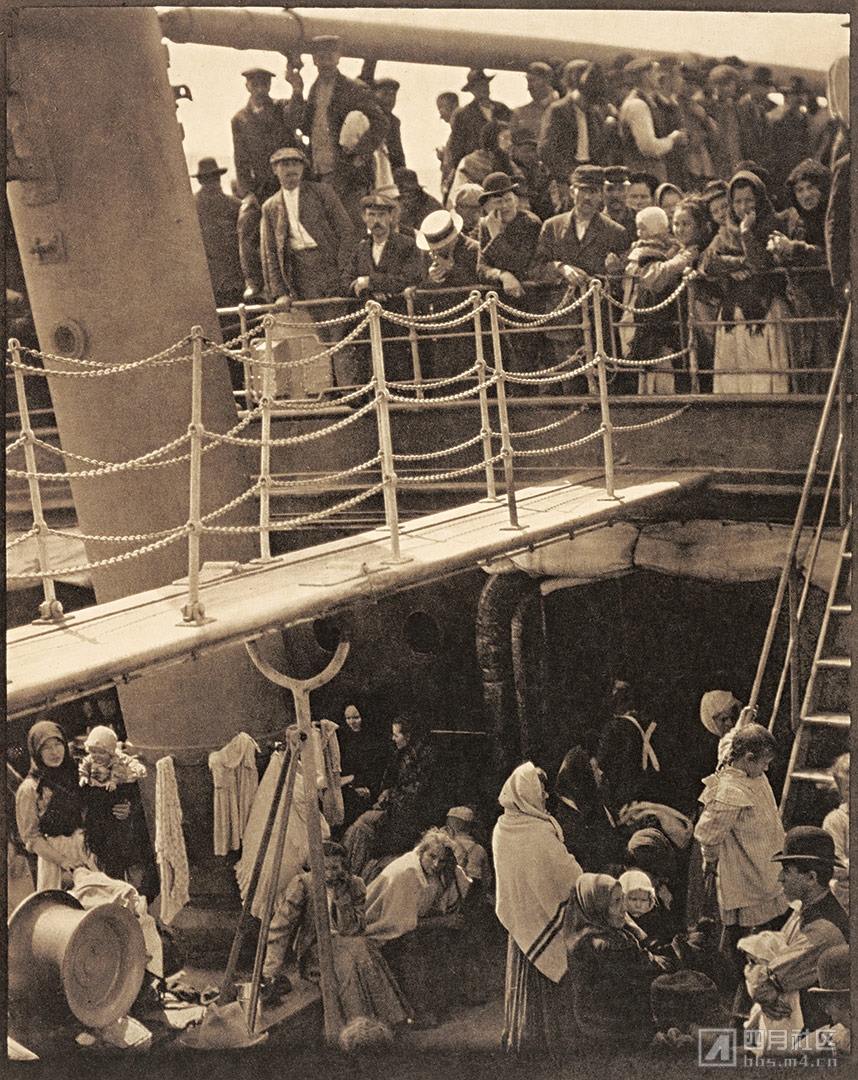
作为摄影分离派运动的领导者,阿尔弗雷德•斯蒂格里茨工匠摄影方式来寻找世间的美。他举办同代摄影师的先锋作品展,出版其作品,试图让这个依然稚嫩的艺术形式与绘画并肩而立。但是,当现代主义在20世纪初让文化界躁动不堪的时候,斯蒂格里茨开始对社会中越来越不和谐的基调着迷,高耸入云的摩天大楼和呼啸而过的飞机。因此他努力开创所谓的“纯粹摄影”,即不做任何改变地呈现真实的世界。1907年,他前往欧洲,随身携带着4×5速格拉菲照相机。他走过拥挤不堪的轮船统舱,走向头等舱甲板。头戴围巾和身缠布带的人在下层甲板挤作一团,轮船倾斜的调度让这些人身处的具有幽闭恐惧感的船舱,在视觉上与上策甲板形成鲜明的对比。斯蒂格里茨后来写到:“一个圆草帽、左边倾斜的烟囱、右边的扶梯、白色的吊桥、铁链做成的扶手。我出神地站了一会,各种形状结合在一起——一副形状的图像,一种崭新的景象吸引了我。”暂且不论这一瞬间的震撼,斯蒂格里茨的照片清晰、毫不妥协地来源于真实生活。它被埋没了4年,但是当它作为《照相机作品》杂志的封面被发表之后,“统舱”引发了人们对摄影这门艺术全新的思考方式。它不是对绘画的拙劣模仿,而是一种全新、独特的艺术形式。在当时的艺术界,这是天翻地覆的革命。随着对后世有深远影响的伟大艺术家的出现,比如作曲家伊戈尔•斯特拉文斯基和建筑师瓦尔特•格罗皮乌斯,摄影具有了与其它新兴艺术形式并驾齐驱的地位。巴勃罗•毕加索推崇“统舱”的立体感,说他和斯蒂格里茨“有相同的精神指引自己的工作”。
纺织厂女孩
路易斯•海因
1908年
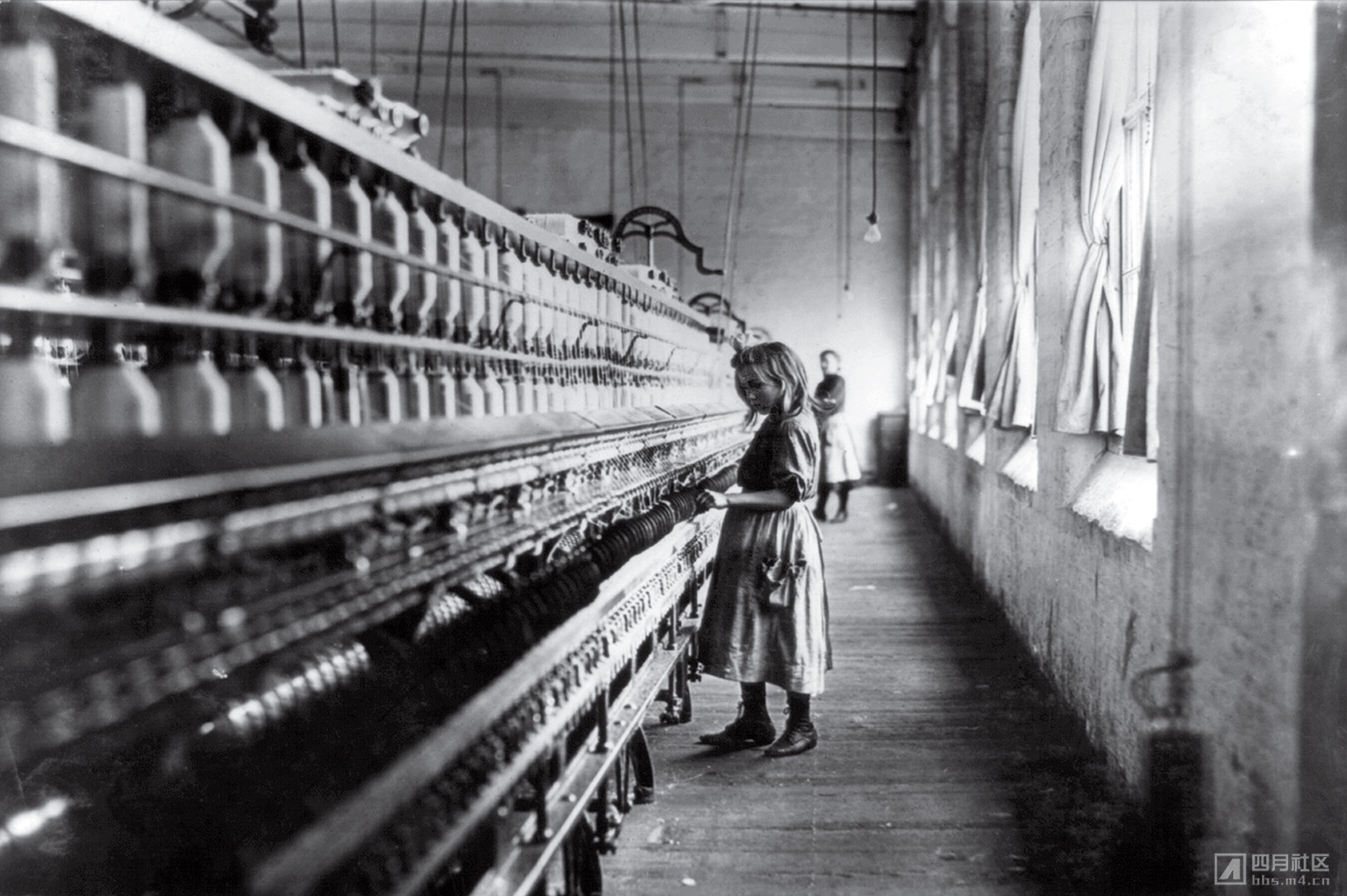
作为国家童工委员会的调查员摄影师,路易斯•海因认为童工的照片会促使公民努力做出改变。将内情昭示天下的决心让他走进从马萨诸塞州到南卡罗来纳州的工厂,他装扮成圣经推销员、保险代理和工业摄影师,以便真正观察到将近200万童工的境况。他随身携带一个大型的照相机,在一个小本子上匆匆记下了解到的信息。他记录了肉类加工厂、煤矿和罐头厂使用童工的现象。1908年11月,他遇到了萨迪•菲佛——这个他试图揭露的黑暗世界的缩影。这个身高只有48英寸的小女孩,作为“无数童工之一”,在南卡罗来纳州兰卡斯特操作一个巨大的棉纺机。海因往往需要通过说谎来骗取拍摄照片的机会,他“保证所有照片都是100%真实的,没有任何后期加工和伪造”。照片中,8岁的小女孩与巨大、冰冷的机器齿轮形成鲜明的对比,让公众感受到对童工现象的恐惧气氛,从而引发立法机构的介入。从1910年到1920年,童工数量减少了将近一半。
盲
保罗•斯特兰德
1916年
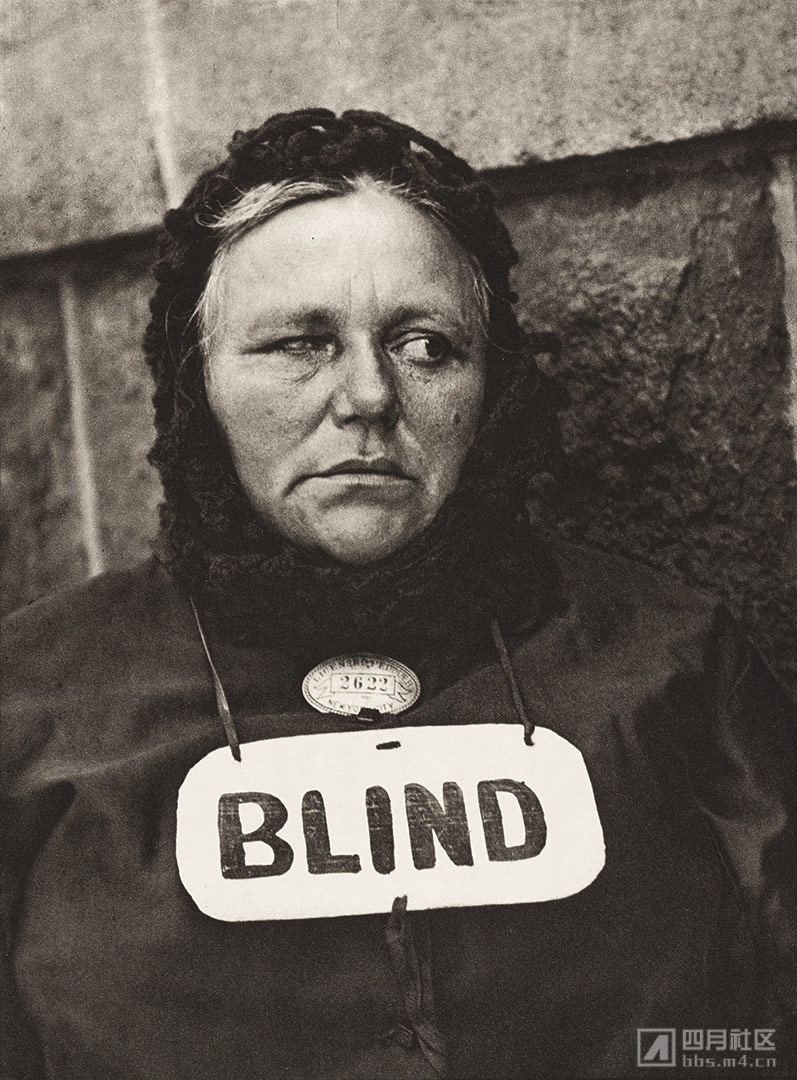
即使她看得见,保罗•斯特兰德这张具有开创意义的照片中的这个女人,或许也不知道她在被拍照。斯特兰德想要捕捉到人们自然的状态,不是他们希望自己呈现的状态。于是在尝试记录纽约市东区移民生活的时候,他使用了一个带有假镜头的照相机,看起来他对准了一个方向,实际上拍摄的是另一个方向。他的作品自然、真实,与那个时代人们姿势僵硬的肖像照截然不同。斯特兰德拍摄了这个失明的女人,他说她当时在街头卖报纸。这是一个随手拍摄的作品,女人并没有面对镜头。在这个国家被汹涌而来的移民逐渐改变时,斯特兰德的作品不仅仅记录了一个勇敢女人的瞬间,而且通过在拍摄对象不知情,或者不同意的情况下进行拍摄,并且用这些照片来提升公众的关注的手法,他创立了一个崭新的纪录片艺术形式——街头摄影。
搬砖男孩
奥古斯特•桑德尔
1928年

奥古斯特•桑德尔的摄影有一种固定的模式可以遵循,但这恰恰是他的目的。这位出生于德国的摄影师同样极为直接的方式来表现医生、农民、厨师和乞丐,他让每一个人都变成了普通人。他试图让人们了解,社会不同阶层之间蕴含着极为丰富的信息:“我们根据外表就可以判断一个人是做什么的,不是做什么的。我们可以通过面目识别出一个人高兴还是忧伤,因为生活的经历在他们身上留下了印记。”桑德斯最知名的肖像作品——德国科隆的一位搬砖工——体现出他的真知灼见。尽管他的工作必然伴随着劳累和汗水,但他依然是一副骄傲的姿态。经典的取景、砖块的线条投射在马甲上,进一步加强了照片主题的尊严感。对于一个挣扎在一战后遭受羞辱的痛苦中的国家来说,这不是一件小事。桑德斯把“搬砖男孩”和其它肖像作品汇总在里程碑式的作品《20世纪的人》中,这是第一部通过摄影来记录文化的作品。桑德斯的摄影推崇个人的重要意义,把普通人的肖像摄影提升到艺术的高度。
海牙
埃里希•所罗门
1930年

大腹便便的政治家经常聚在一起决定各个国家的命运,雪茄和白兰地随时伺候。但他们总是藏在众人目光之后。德国摄影记者埃里希•所罗门改变了这一点,他拿着一台可以在低光环境中拍摄的、小巧的莱卡照相机,偷偷溜入了烟雾弥漫的房间。让他的技巧得到最充分展示的是1930年海牙有关德国一战赔款的会议。凌晨2点,经过整整一天漫长的协商,所罗门大大方方地拍摄了筋疲力尽的外交部长们。这张照片在《伦敦画报》发表之后引起了轰动。公众第一次看到藏在权力大门之后,领导人放松警戒的景象。所罗门12年之后在奥斯威辛去世,他开创了幕后政治新闻摄影行业。
圣拉扎尔车站后门
亨利•卡蒂埃•布列松
1932年
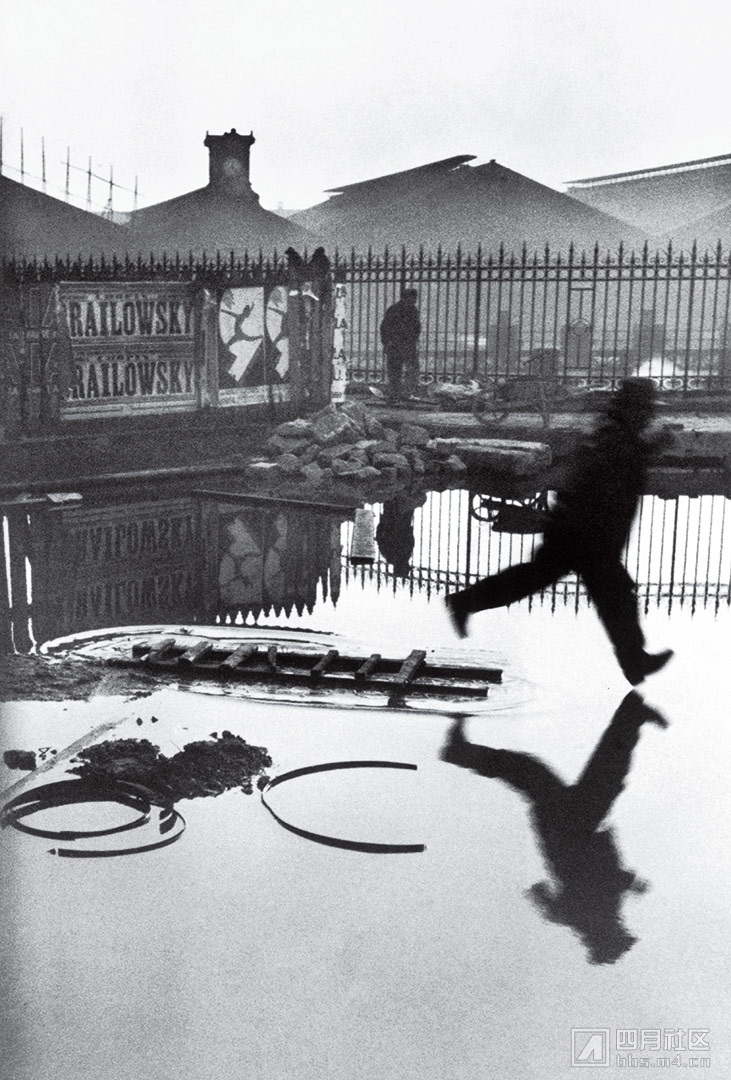
速度和直觉是亨利•卡蒂尔•布列松作为一名摄影师最核心的聪明才智。在1932年的一天,他把这两个特质完美地结合起来,他的莱卡照相机镜头对准了巴黎圣拉扎尔车站后面的篱笆墙。所带来的是一张取景与光线完美结合的大师级作品。一个人跳过地上的水,与后面墙上海报的舞者遥相呼应。梯子旁水波的涟漪与附近弯曲的金属条如出一辙。卡蒂尔•布列松使用的是小巧的35毫米照相机,没有闪光灯,他看到所有的元素在一瞬间凑在一起,于是按下了快门。时机就是一切,没有任何一个摄影师能超过布列松对时机的把握。这张照片是卡蒂尔•布列松“决定性时刻”的精髓体现,他用这个词来描述摄影师让一瞬变成永久的能力。快速、动态、关注细节,决定了所有现代摄影的发展方向。
摩天大楼上的午餐
摄影师不详
1932年
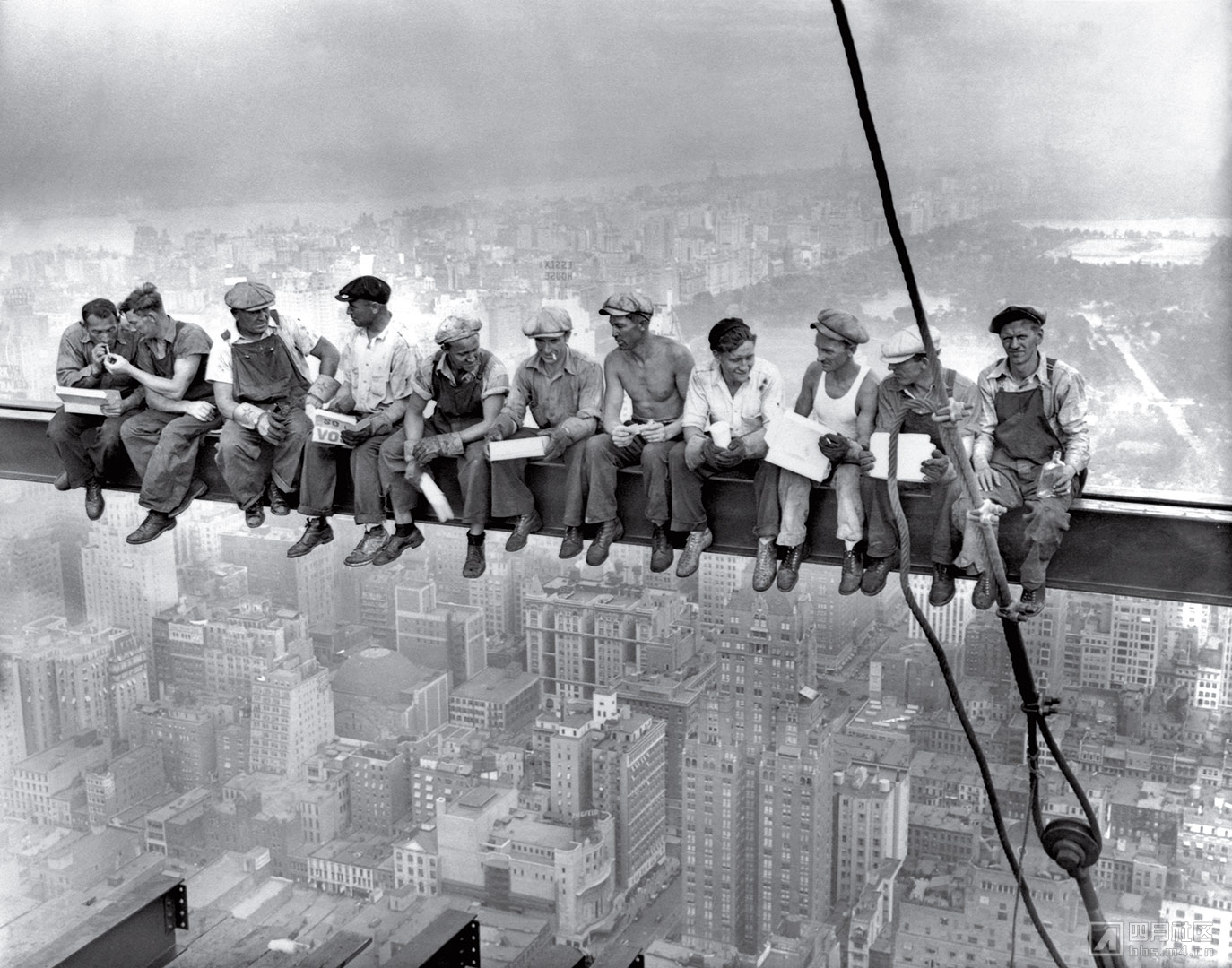
这是一张最危险,也是最有趣的午餐照片:11个人姿态随意地吃饭、聊天、吸烟,好像他们并不是身处距离曼哈顿地面840英尺的一根细细的钢梁上。舒适的感觉并非伪装而来,他们都是洛克菲勒忠心的建筑工人。但是这张拍摄于RCA大厦(现在改名为GE大厦)69层楼的照片,最早被用来宣传纽约的摩天大楼建筑群。摄影师和大部分工人的身份已不可考,摄影师查尔斯•C•艾比特、托马斯•凯利和威廉•莱弗特维奇当天都在现场,但不知道是谁按下的快门。美国的每一个炼钢工人都看到过这张照片,这是他们行业的骄傲。从这个意义上说,他们并不孤单。“摩天大楼上的午餐”表达了对危险和经济萧条不屑一顾的态度,它象征着美国的坚韧和雄心,在当时,这恰恰是这个国家最需要的东西。它成为了这座城市的标志,强化了人们心中对纽约的浪漫印象,这里的人不惧怕建造巨大的建筑物,全世界都不放在眼里。正如所有匆忙建造的标志性建筑物一样,“摩天大楼上的午餐”也释放出自己的经济能量。科比斯图片社制作了大量相关的图片。如果你走在时代广场,恐怕不会错过出售带有这张图片的杯子、冰箱贴和T恤衫的小贩。
身穿浣熊皮大衣的夫妇
詹姆斯•范德奇
1932年
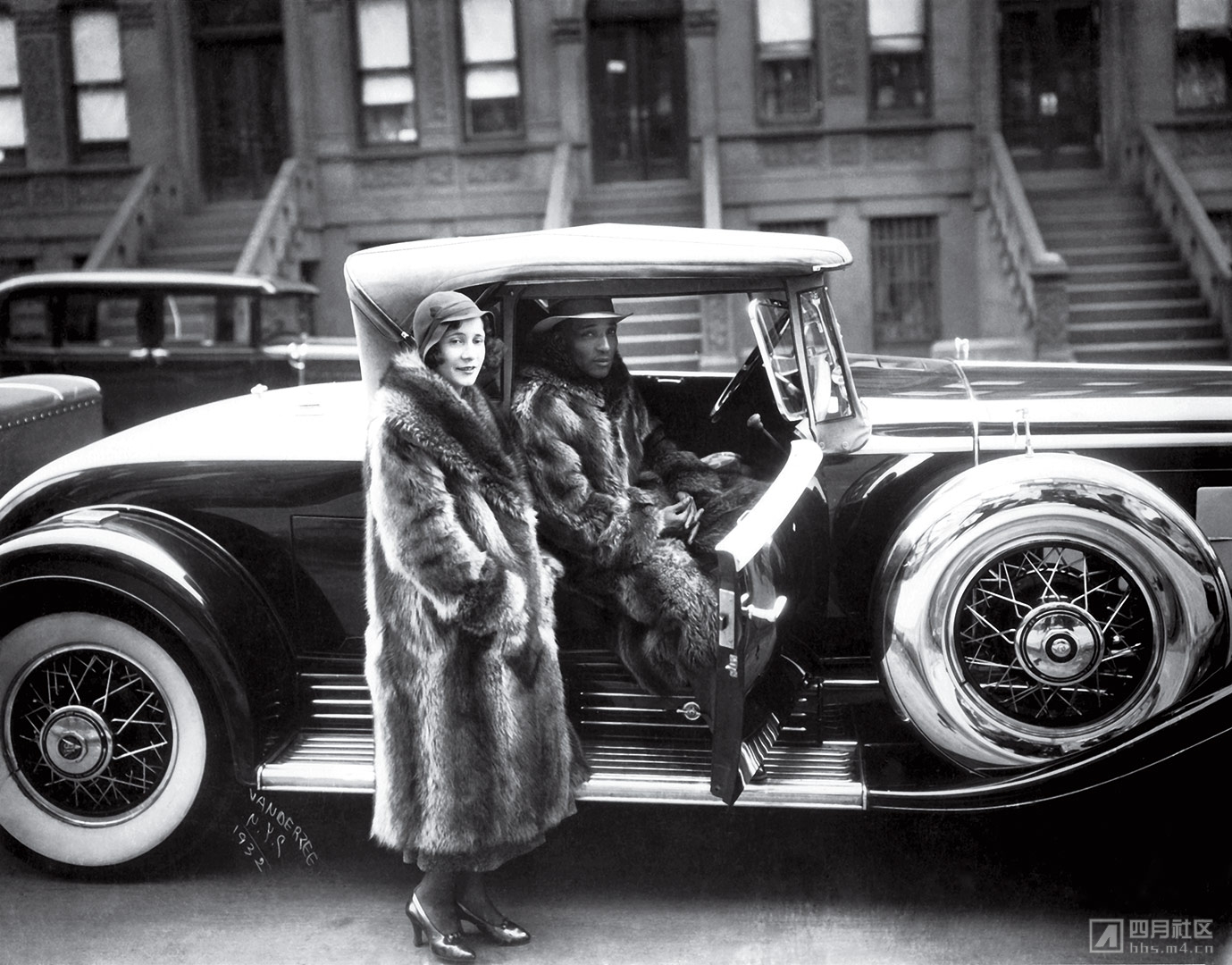
对大部分生活在20世纪30年代的美国白种人来说,黑人不过是仆人和奴工,他们普遍被无视、被遗忘。但是詹姆斯•范德奇透过镜头看到的并不是这样。为了扭转流行文化中铺天盖地对非裔美国人的夸张性侮辱,范德奇不但拍摄了黑人居住区的婚礼、葬礼、俱乐部和家庭,还拍摄了黑人爱国人士马库斯•加维、舞蹈家比尔•“踢踏舞”•罗宾逊和诗人康提•卡伦——他是哈莱姆文艺复兴运动的领导人、艺术家、作家和推动者。在他位于黑人街区的摄影室里,范德奇拍摄的人像照都经过一丝不苟的安排,人物彰显出他们所希望展示的形象。把这一点表达得最明显的,是他那张热情洋溢的照片——一对英俊的夫妇穿着浣熊皮大衣,在一辆凯迪拉克跑车旁边。时尚的背景——范德奇制作的道具——挑战着公众对种族、阶级和成功的旧观念,它成为了一个具有远大志向的典范,让几代非裔美国人进一步渴望实现真正的美国梦。
尼斯湖水怪
摄影师不详
1934年

假如世界上没有长颈鹿这种动物,我们多半也会创造出一个。对现实中存在的奇怪生物熟视无睹,而去寻找那些不可能存在的东西,是我们的天性。这就是所谓尼斯湖水怪的照片让我们得到的教训,据说英国医生罗伯特•威尔逊在1934年4月拍下这张照片。但是,威尔逊仅仅是被人当作掩盖以前一个欺骗事件的牺牲者。马尔马杜克•韦特雷尔是一个荒野猎人,他被伦敦的《每日邮报》派往苏格兰去抓捕怪兽。那里根本没有怪兽,韦特雷尔带回一些照片,说这是尼斯湖怪的脚印。《每日邮报》识破了他的谎言,说他是个骗子,韦特雷尔于是回到尼斯湖,用玩具潜水艇做了一个怪兽。他和他的儿子让威尔逊这位富有声望的医生证实这张照片的真实性,以便继续他们的谎言。《每日邮报》没有遭受太大的打击,但是威尔逊声名扫地。
尼斯湖水怪的照片就像一块磁石,吸引着阴谋理论者和寻找传说的人,就像海盗号火星探测器在1976年拍摄的那张百分之百真实的著名火星面孔。照片所引发的惊恐持续到1998年,火星全球探勘者号证实,正如美国宇航局所说,那只是地形上的一个结构,现在已经被风吹散。在那个甜蜜的PS技术出现之前的年代,我们既天真又无知。现在我们成熟了,我们什么也不相信了。造假的艺术在不断进步,但是它的魅力,就像火星面孔一样,远远没有褪去。
原文:
The Vanishing Race
Edward S. Curtis
1904
Native Americans were the great casualty of the U.S.’s grand westward advance. As settlers tamed the seemingly boundless stretches of the young nation, they evicted Indians from their ancestral lands, shoving them into impoverished reservations and forcing them to assimilate. Fearing the imminent disappearance of America’s first inhabitants, Edward S. Curtis sought to document the assorted tribes, to show them as a noble people—“the old time Indian, his dress, his ceremonies, his life and manners.” Over more than two decades, Curtis turned these pictures and observations into The North American Indian, a 20-volume chronicle of 80 tribes. No single image embodied the project better than The Vanishing Race, his picture of Navajo riding off into the dusty distance. To Curtis the photo epitomized the plight of the Indians, who were “passing into the darkness of an unknown future.” Alas, Curtis’ encyclopedic work did more than convey the theme—it cemented a stereotype. Railroad companies soon lured tourists west with trips to glimpse the last of a dying people, and Indians came to be seen as a relic out of time, not an integral part of modern American society. It’s a perception that persists to this day.
The Steerage
Alfred Stieglitz
1907
As a leader of the Photo-Secession movement, Alfred Stieglitz searched for beauty through the craftsmanlike creation of photographs, held pioneering exhibitions of his contemporaries, published their works and sought to have the still nascent art form taken as seriously as painting. But as modernism seeped into the cultural ferment in the early 20th century, Stieglitz became mesmerized by the growing cacophony of society, of rising skyscrapers and soaring airplanes, and strove to create what he termed “straight photography,” offering truthful takes on the real world. In 1907 he was sailing to Europe, 4x5 Speed Graflex in tow, when he set off from the first-class deck and came upon the huddled masses in the ship’s steerage. There, the shawled and swathed were crammed together on the compact lower deck, the skewed geometry of the ship emphasizing their claustrophobic accommodations and visually segregating them from those on the upper deck. “A round straw hat; the funnel leaning left, the stairway leaning right; the white drawbridge, its railings made of chain,” Stieglitz later wrote. “I stood spellbound for a while. I saw shapes related to one another—a picture of shapes, and underlying it, a new vision that held me.” Despite its momentary impact, Stieglitz’s photo, with its clear, unapologetic take on life, lay unnoticed for four years. But when he published it on the cover of his magazine Camera Work, The Steerage presented a radical way of thinking about photography, not as a momentary mimic of painting but a wholly formed and unique type of art. Appearing at the time of a seismic revolution in the arts, with the emergence of such seminal figures as the composer Igor Stravinsky and the architect Walter Gropius, this, one of the first “modernist” pictures, helped photography to be seen on a par with these other innovative forms of art. None other than the painter Pablo Picasso admired The Steerage’s cubistic sense and wrote that both he and Stieglitz were “working in the same spirit.”
Cotton Mill Girl
Lewis Hine
1908
Working as an investigative photographer for the National Child Labor Committee, Lewis Hine believed that images of child labor would force citizens to demand change. The muckraker conned his way into mills and factories from Massachusetts to South Carolina by posing as a Bible seller, insurance agent or industrial photographer in order to tell the plight of nearly 2 million children. Carting around a large-format camera and jotting down information in a hidden notebook, Hine recorded children laboring in meatpacking houses, coal mines and canneries, and in November 1908 he came upon Sadie Pfeifer, who embodied the world he exposed. A 48-inch-tall wisp of a girl, she was “one of the many small children at work” manning a gargantuan cotton-spinning machine in Lancaster, S.C. Since Hine often had to lie to get his shots, he made “double-sure that my photo data was 100% pure—no retouching or fakery of any kind.” His images of children as young as 8 dwarfed by the cogs of a cold, mechanized universe squarely set the horrors of child labor before the public, leading to regulatory legislation and cutting the number of child laborers nearly in half from 1910 to 1920.
Blind
Paul Strand
1916
Even if she could see, the woman in Paul Strand’s pioneering image might not have known she was being photographed. Strand wanted to capture people as they were, not as they projected themselves to be, and so when documenting immigrants on New York City’s Lower East Side, he used a false lens that allowed him to shoot in one direction even as his large camera was pointed in another. The result feels spontaneous and honest, a radical departure from the era’s formal portraits of people in stilted poses. Strand’s photograph of the blind woman, who he said was selling newspapers on the street, is candid, with the woman’s face turned away from the camera. But Strand’s work did more than offer an unflinching look at a moment when the nation was being reshaped by a surge of immigrants. By depicting subjects without their knowledge—or consent—and using their images to promote social awareness, Strand helped pave the way for an entirely new form of documentary art: street photography.
Bricklayer
August Sander
1928
There is a certain formulaic approach to August Sander’s photography. But that was his aim. By presenting doctors, farmers, chefs and beggars all with the same stark directness, the German-born Sander made everyone the everyman. He set out to show that there is much to learn from all layers of society, noting, “We can tell from appearance the work someone does or does not do; we can read in his face whether he is happy or troubled, for life unavoidably leaves its trace there.” Sander’s most celebrated portrait, of a bricklayer in Cologne, Germany, embodies that insight. For while the laborer’s work entails toil and sweat, he maintains a proud bearing. The classical framing, with the lines of the bricks evoking the lines of the bricklayer’s vest, reinforces the dignity of the subject. Which was no small thing for a nation still reeling from the humiliation of World War I. Sander gathered Bricklayer and his other portraits in the monumental People of the 20th Century, the first body of work to document a culture through photography. Sander’s photographs celebrate the importance of the individual, elevating portraiture of ordinary people to art.
The Hague
Erich Salomon
1930
Portly statesmen have long gathered to weigh the fate of nations, cigars and brandy at the ready. But they were always sequestered far from prying eyes. The German photojournalist Erich Salomon changed all that, slipping into those smoke-filled back rooms with a small Leica camera built to shoot in low light. Nowhere was his skill on greater display than during a 1930 meeting in the Hague over German World War I reparations. There, at 2 a.m., Salomon candidly shot exhausted Foreign Ministers after a long day of negotiations. The picture created a sensation when it was published in the London Graphic. For the first time, the public could look through the doors of power and see world leaders with their guard down. Salomon, who died in Auschwitz 12 years later, had created backstage political photojournalism.
Behind the Gare Saint-Lazare
Henri Cartier-Bresson
1932
Speed and instinct were at the heart of Henri Cartier-Bresson’s brilliance as a photographer. And never did he combine the two better than on the day in 1932 when he pointed his Leica camera through a fence behind Paris’ Saint-Lazare train station. The resulting image is a masterpiece of form and light. As a man leaps across the water, evoking the dancers in a poster on the wall behind him, the ripples in the puddle around the ladder mimic the curved metal pieces nearby. Cartier-Bresson, shooting with a nimble 35-millimeter camera and no flash, saw these components all come together for a brief moment and clicked his shutter. Timing is everything, and no other photographer’s was better. The image would become the quintessential example of Cartier-Bresson’s “Decisive Moment,” his lyrical term for the ability to immortalize a fleeting scene on film. It was a fast, mobile, detail-obsessed style that would help chart the course for all of modern photography.
Lunch Atop a Skyscraper
Unknown
1932
It’s the most perilous yet playful lunch break ever captured: 11 men casually eating, chatting and sneaking a smoke as if they weren’t 840 feet above Manhattan with nothing but a thin beam keeping them aloft. That comfort is real; the men are among the construction workers who helped build Rockefeller Center. But the picture, taken on the 69th floor of the flagship RCA Building (now the GE Building), was staged as part of a promotional campaign for the massive skyscraper complex. While the photographer and the identities of most of the subjects remain a mystery—the photographers Charles C. Ebbets, Thomas Kelley and William Leftwich were all present that day, and it’s not known which one took it—there isn’t an ironworker in New York City who doesn’t see the picture as a badge of their bold tribe. In that way they are not alone. By thumbing its nose at both danger and the Depression, Lunch Atop a Skyscraper came to symbolize American resilience and ambition at a time when both were desperately needed. It has since become an iconic emblem of the city in which it was taken, affirming the romantic belief that New York is a place unafraid to tackle projects that would cow less brazen cities. And like all symbols in a city built on hustle, Lunch Atop a Skyscraper has spawned its own economy. It is the Corbis photo agency’s most reproduced image. And good luck walking through Times Square without someone hawking it on a mug, magnet or T-shirt.
Couple in Raccoon Coats
James VanDerZee
1932
To many white Americans in the 1930s, black people were little more than domestics or sharecroppers. They were ignored, invisible, forgotten. But that was not what James VanDerZee saw when he gazed through his camera lens. Seeking to counter the degrading and widely disseminated caricatures of African Americans in popular culture, VanDerZee not only photographed Harlem weddings, funerals, clubs and families but also chronicled the likes of black nationalist Marcus Garvey, dancer Bill “Bojangles” Robinson and the poet Countee Cullen—the leaders, artists, writers, movers and strivers of the Harlem Renaissance. In his Guarantee Photo Studio and along the neighborhood’s streets, VanDerZee crafted portraits that were meticulously staged to celebrate the images his subjects wanted to project. And nowhere is this pride more evident than in his glowing picture of a handsome couple sporting raccoon coats beside a Cadillac roadster. The swish backdrop—props curated by VanDerZee—challenged popular perceptions about race, class and success and became an aspirational model for generations of African Americans yearning for a full piece of the American Dream.
The Loch Ness Monster
Unknown
1934
If the giraffe never existed, we’d have to invent it. It’s our nature to grow bored with the improbable but real and look for the impossible. So it is with the photo of what was said to be the Loch Ness monster, purportedly taken by British doctor Robert Wilson in April 1934. Wilson, however, had simply been enlisted to cover up an earlier fraud by wild-game hunter Marmaduke Wetherell, who had been sent to Scotland by London’s Daily Mail to bag the monster. There being no monster to bag, Wetherell brought home photos of hippo prints that he said belonged to Nessie. The Mail caught wise and discredited Wetherell, who then returned to the loch with a monster made out of a toy submarine. He and his son used Wilson, a respected physician, to lend the hoax credibility. The Mail endures; Wilson’s reputation doesn’t.
The Loch Ness image is something of a lodestone for conspiracy theorists and fable seekers, as is the absolutely authentic picture of the famous face on Mars taken by the Viking probe in 1976. The thrill of that find lasted only until 1998, when the Mars Global Surveyor proved the face was, as NASA said, a topographic formation, one that by that time had been nearly windblown away. We were innocents in those sweet, pre-Photoshop days. Now we know better—and we trust nothing. The art of the fake has advanced, but the charm of it, like the Martian face, is all but gone.
|
|